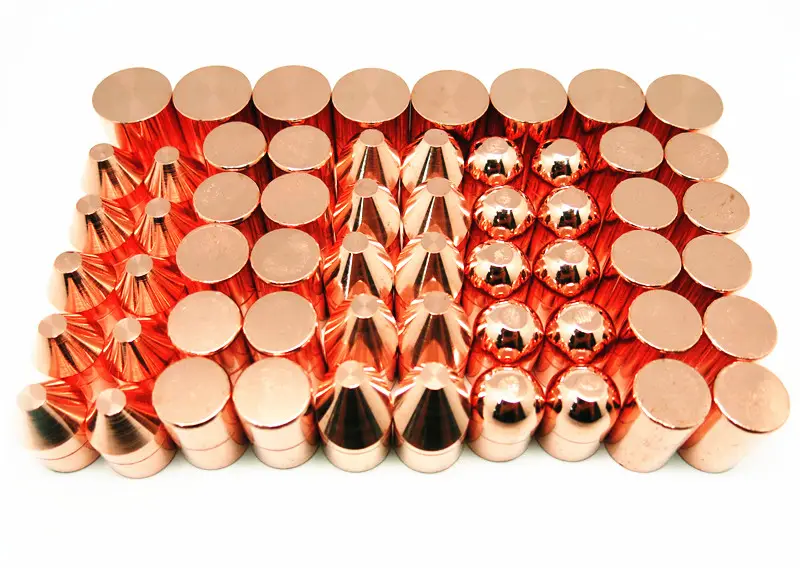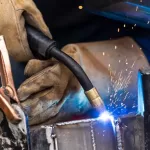In this guide, we will discuss when to replace MIG welding contact tips, reasons for a short contact tip life, and how to extend the life of your contact tips. Whether you’re a beginner or looking to optimize your welding tips, this guide will provide valuable information to save you time and money.
You’re a beginner to MIG welding and you’re just getting started
Welding Town
You want to optimize the life of your MIG welding tips to save time and money
Recognizing When to Replace Your MIG Welding Contact Tips: 5 Signs to Look For
Similar to symptoms of a disease, there are certain signs that indicate it’s time to replace your welding tips. Here are five signs to help you recognize when to replace them:
- Burnbacks: When the wire melts and fuses to the contact tip, causing arc instability, irregular wire feeding, and stoppages in wire feeding. Adjustments in the welding machine settings may be required to eliminate burnbacks.
- Wear: Evident erosion in the MIG contact tip bore caused by friction of the wire feeding through the bore. Wear can lead to wire placement offset, erratic arcs, and irregular welds. In robotic welding, it can cause missed weld joints by modifying the Tool Center Point of your MIG gun.
- Oval-Shaped Contact Tip (Keyholing): Overuse of the contact tip can cause it to adopt an oval shape bore. An oval contact tip bore can result in an erratic arc and lower the quality of your welding. In robotic welding, it can also cause missed weld joints.
- Excessive Pounds of Wire: When a contact tip has processed over 100 pounds of wire, it may show signs of wear. After surpassing the 100-pound mark, the worn contact tip can lower the quality of welding, leading to issues such as erratic arcs and offset welding.
- Lots of Metal Debris and Spatter on the Tip: While some spatter and metal debris are normal, excessive amounts indicate the need for a contact tip replacement. Too much debris on the welding tip can diminish the quality of arcing and welding, potentially leading to burnbacks.
If you’re experiencing any of these signs, it’s time to replace your contact tip to maintain the quality of your welding.
Reasons for Short MIG Contact Tip Life: The 4 Leading Causes
Understanding the causes of short contact tip life can help you address and rectify them. Here are the four leading causes:
- Wrong Tip Size: Using the wrong tip size can result in poor electrical conductivity and micro-arcing, affecting the quality of welding and shortening the life of the contact tip. Choose the right contact tip size based on the wire diameter and type.
- Wrong MIG Tip Alloy: Selecting the wrong alloy for the temperature and intensity of the project can shorten the life of the contact tip. Choose the appropriate alloy that matches the requirements of your welding job.
- Dirty Welding Wire: Using dirty or low-quality welding wire can cause failures in the contact tip, leading to a shortened life. Ensure the wire is clean to avoid complications during wire feeding and the need for frequent contact tip replacements.
- Surpassing the Amperage Range of Your MIG Gun: If your contact tip has turned blue, black, or purple, it indicates that you have exceeded the Amperage range and duty cycle of your MIG gun. Ensure you choose the right amperage or have proper cooling features to dissipate heat when working with high amperages.
By addressing these causes, you can extend the life of your contact tips and improve welding efficiency.
How to Extend the Life of Your MIG Welding Contact Tip: 5 Easy Steps
To maximize the efficiency and lifespan of your contact tips, follow these five steps:
- Optimize Wire Feeding: Trim the MIG welding gun liner to the appropriate length, shorten power cables to ensure optimal feeding, and loosen the drive roll for smooth wire feeding without deformations.
- Work with Low Temperatures When Possible: Higher temperatures increase electrical wear on contact tips. Consider using a water-cooled MIG welding gun for high-amp applications, using larger diameter contact tips, or investing in high-quality MIG consumables designed to minimize heat concentration.
- Choose the Right MIG Welding Contact Tips: Select the appropriate contact tip alloy for your welding application. Copper tips are suitable for hand-welding, while copper-chrome-zirconium (CuCrZr) tips are ideal for robotic welding with high temperatures and duty cycles.
- Remove Spatter and Debris: Regularly clean the contact tip to remove spatter and debris. Excessive buildup can lead to arcing and the need for frequent replacements.
- Use Contact Tips with a Smooth Surface: Opt for contact tips with a smooth surface to prevent spatter buildup and extend their functional life.
By implementing these steps, you can extend the useful life of your MIG welding contact tips, improve welding quality, and reduce operational costs.
In conclusion, knowing when to replace MIG welding contact tips and how to extend their lives is crucial for efficient welding operations. By recognizing the signs of replacement, addressing common causes of short tip life, and implementing practices to extend tip longevity, you can optimize your welding performance, save time, and reduce costs.
Note: This guide was provided to assist with MIG welding contact tips and their maintenance. For specific product recommendations and replacements, refer to the mentioned brands or consult with welding experts to ensure compatibility and optimal results.












